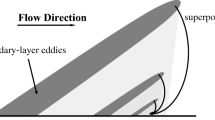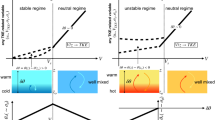Abstract
This study addresses the phenomenon of persistent countergradient (PCG) fluxes of momentum and heat (density) as observed in homogeneous turbulence forced by shear and stratification. Countergradient fluxes may occur at large scales when stratification is strong. However, they always occur at small scales, independently of stratification. A conceptional model is introduced to explain PCG fluxes at small scales as the result of the collision of large-scale fluid parcels. The large parcels collide under the driving force of inclined vortex structures (in a shear-dominated flow) or of buoyancy (in a strongly stratified shear flow). This “collision model” also explains the PCG heat flux in an unsheared stratified flow with zero average momentum flux. It is found that the energy of the small-scale PCG motions is provided (i) by quick transport of kinetic energy from the scales of production to relatively slowly dissipating scales if the flow is shear-driven and (ii) by conversion of available potential energy to kinetic energy at small scales when the flow is stratified. The collision mechanism is an inherent property of the turbulence dynamics. Therefore, the PCG fluxes at small scales reflect a universal character of homogeneous turbulence, and are found over a large range of Reynolds numbers. The Prandtl (or Schmidt) number influences the rate of dissipation of temperature (or density) variance but not the dissipation rate of the velocity variance. In stratified flows, therefore, the number directly affects the strength of the PCG heat flux at small scales. It is found, however, that the PCG momentum flux is also altered slightly when the Prandtl number is large enough to sustain small buoyantly moving parcels after collision.
Similar content being viewed by others
References
Gerz, R. (1991). Coherent structures in stratified turbulent shear flows deduced from direct simulations. In: Turbulence and Coherent Structures (eds. O. Métais and M. Lesieur), Kluwer, Dordrecht, pp. 449–468.
Gerz, T., and Schumann, U. (1991). Direct simulations of homogeneous turbulence and gravity waves in sheared and unsheared stratified flows. In: Turbulent Shear Flow, vol. 7 (eds. F. Durst et al.), Springer-Verlag, New York, pp. 27–45.
Gerz, T., and Yamazaki, H. (1993). Direct numerical simulation of buoyancy driven turbulence in stably stratified fluid. J. Fluid Mech., 249, 415–440.
Gerz, T., Schumann, U., and Elghobashi, S.E. (1989). Direct numerical simulation of stratified homogeneous turbulent shear flows. J. Fluid Mech., 200, 563–594.
Gerz, T., Howell, J., and Mahrt, L. (1994). Vortex structures and microfronts. Phys. Fluids A, 6, 1242–1251.
Härtel, C., and Kleiser, L. (1993). Large-eddy simulation of transitional and turbulent wall-bounded flows. In: Flow Simulation with High-Performance Computers, vol. I (ed. E.H. Hirschel), Vieweg-Verlag, Braunschweig, pp. 169–185.
Holloway, G. (1988). The buoyancy flux from internal gravity wave breaking. Dyn. Atmos. Oceans, 12, 107–125.
Holt, S.E., Koseff, J.R., and Ferziger, J.H. (1992). A numerical study of the evolution and structure of homogeneous stably stratified sheared turbulence. J. Fluid Mech., 237, 499–539.
Itsweire, E.C., and Helland, K.N. (1989) Spectra and energy transfer in stably stratified turbulence. J. Fluid Mech., 207, 419–452.
Itsweire, E.C., Helland, K.N., and van Atta, C.W. (1986). The evolution of grid-generated turbulence in a stably stratified fluid. J. Fluid Mech., 162, 299–338.
Kaltenbach, H.-J., Gerz, T., and Schumann, U. (1991). Transport of passive scalars in neutrally and stably stratified homogeneous turbulent shear flows. In: Advances in Turbulence, vol. 3 (eds. A. Johansson and P. Alfredsson). Springer-Verlag, Berlin, pp. 327–334.
Kaltenbach, H.-J., Gerz, T., and Schumann, U. (1994). Large-eddy simulation of homogeneous turbulence and diffusion in stably stratified shear flow. J. Fluid Mech., 280, 1–40.
Komori, S., and Nagata, K. (1994). Heat and mass transfer in stably stratified flows. Presented at Fourth Internat. Symp. on Stratified Flows, June 29 to July 2, 1994, Grenoble.
Komori, S., Ueda, H., Ogino, F., and Mizushina, T. (1983). Turbulence structure in stably stratified open-channel flow. J. Fluid Mech., 130, 13–26.
Lienhard, J.H., and van Atta, C.W. (1990). The decay of turbulence in thermally stratified flow. J. Fluid Mech., 210, 57–112.
Munk, W.H. (1981). Internal waves and small-scale processes. In: Evolution of Physical Oceanography (eds. B.A. Warren and C. Wunsch). MIT Press, Cambridge, MA, pp. 264–291.
Ramsden, D., and Holloway, G. (1992). Energy transfers across an internal wave-vortical mode spectrum. J. Geophys. Res., 97, 3659–3668.
Robinson, S.K. (1991). Coherent motions in the turbulent boundary layer. Annu. Rev. Fluid Mech., 23, 601–639.
Rogers, M.M., and Moin, P. (1987). The structure of the vorticity field in homogeneous turbulent flows. J. Fluid Mech., 176, 33–66.
Rohr, J.J., Itsweire, E.C., Helland, K.N., and van Atta, C.W. (1988). Growth and decay of turbulence in a stably stratified shear flow. J. Fluid Mech., 195, 77–111.
Salathé, E.P., and Smith, R.B. (1992). In situ observations of temperature microstructure above and below the tropopause. J. Atmos. Sci., 49, 2032–2036.
Schumann, U. (1987). The countergradient heat-flux in turbulent stratified flows. Nuclear. Engrg. Des., 100, 255–262.
Schumann, U., and Gerz, T. (1995). Turbulent mixing in stably stratified shear flows. J. Appl. Meteorol., 34, 33–48.
Starr, V.P. (1968). Physics of Negative Viscosity Phenomena. McGraw-Hill, New York, 256 pp.
Yoon, K. and Warhaft, Z. (1990). The evolution of grid generated turbulence under conditions of stable thermal stratification. J. Fluid Mech., 215, 601–638.
Author information
Authors and Affiliations
Additional information
Communicated by Jackson R. Herring
Rights and permissions
About this article
Cite this article
Gerz, T., Schumann, U. A possible explanation of countergradient fluxes in homogeneous turbulence. Theoret. Comput. Fluid Dynamics 8, 169–181 (1996). https://doi.org/10.1007/BF00418056
Received:
Accepted:
Issue Date:
DOI: https://doi.org/10.1007/BF00418056




